生物专业英语翻译+蒋悟生+第3版
- 格式:docx
- 大小:107.93 KB
- 文档页数:16
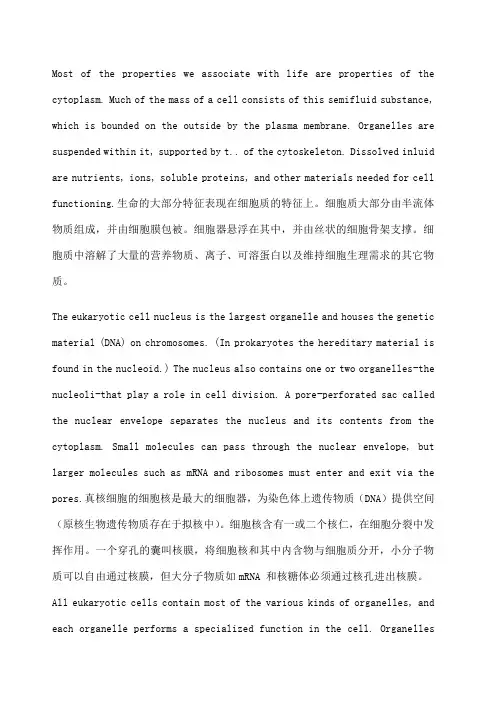
Most of the properties we associate with life are properties of the cytoplasm. Much of the mass of a cell consists of this semifluid substance, which is bounded on the outside by the plasma membrane. Organelles are suspended within it, supported by t.. of the cytoskeleton. Dissolved inluid are nutrients, ions, soluble proteins, and other materials needed for cell functioning.生命的大部分特征表现在细胞质的特征上。
细胞质大部分由半流体物质组成,并由细胞膜包被。
细胞器悬浮在其中,并由丝状的细胞骨架支撑。
细胞质中溶解了大量的营养物质、离子、可溶蛋白以及维持细胞生理需求的其它物质。
The eukaryotic cell nucleus is the largest organelle and houses the genetic material (DNA) on chromosomes. (In prokaryotes the hereditary material is found in the nucleoid.) The nucleus also contains one or two organelles-the nucleoli-that play a role in cell division. A pore-perforated sac called the nuclear envelope separates the nucleus and its contents from the cytoplasm. Small molecules can pass through the nuclear envelope, but larger molecules such as mRNA and ribosomes must enter and exit via the pores.真核细胞的细胞核是最大的细胞器,为染色体上遗传物质(DNA)提供空间(原核生物遗传物质存在于拟核中)。
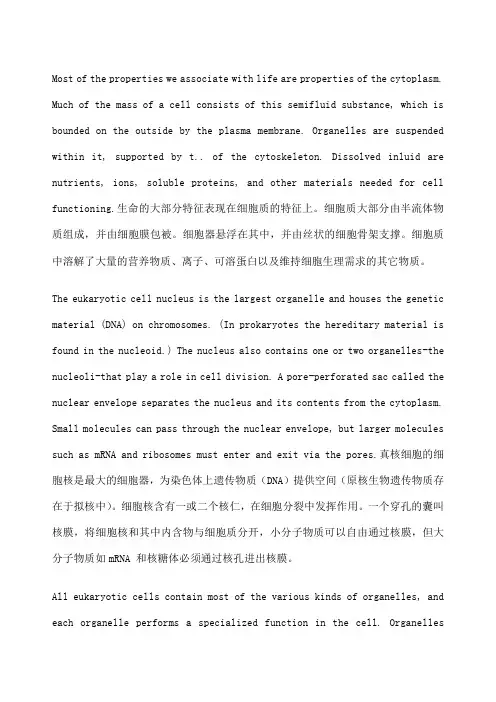
Most of the properties we associate with life are properties of the cytoplasm. Much of the mass of a cell consists of this semifluid substance, which is bounded on the outside by the plasma membrane. Organelles are suspended within it, supported by t.. of the cytoskeleton. Dissolved inluid are nutrients, ions, soluble proteins, and other materials needed for cell functioning.生命的大部分特征表现在细胞质的特征上。
细胞质大部分由半流体物质组成,并由细胞膜包被。
细胞器悬浮在其中,并由丝状的细胞骨架支撑。
细胞质中溶解了大量的营养物质、离子、可溶蛋白以及维持细胞生理需求的其它物质。
The eukaryotic cell nucleus is the largest organelle and houses the genetic material (DNA) on chromosomes. (In prokaryotes the hereditary material is found in the nucleoid.) The nucleus also contains one or two organelles-the nucleoli-that play a role in cell division. A pore-perforated sac called the nuclear envelope separates the nucleus and its contents from the cytoplasm. Small molecules can pass through the nuclear envelope, but larger molecules such as mRNA and ribosomes must enter and exit via the pores.真核细胞的细胞核是最大的细胞器,为染色体上遗传物质(DNA)提供空间(原核生物遗传物质存在于拟核中)。
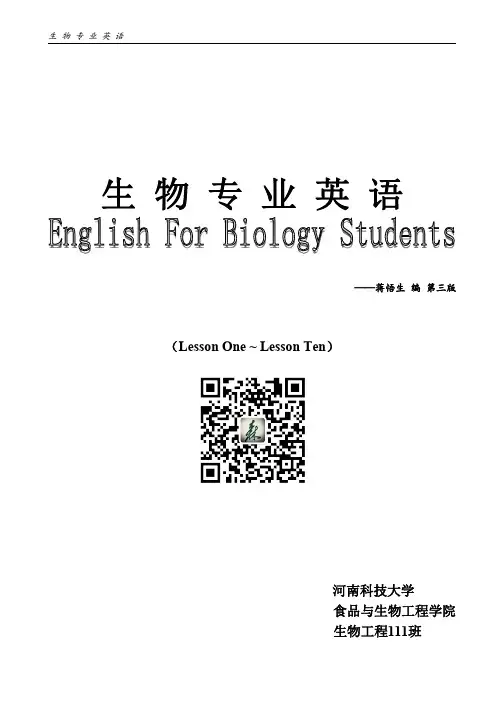
生物专业英语——蒋悟生编第三版(Lesson One~Lesson Ten)河南科技大学食品与生物工程学院生物工程111班Lesson one:Inside the Living Cell:Structure andFunction of Internal Cell PartsCytoplasm:The Dynamic,Mobile Factory细胞质:动力工厂Most of the properties we associate with life are properties of the cytoplasm.Much of the mass of a cell consists of this semifluid substance,which is bounded on the outside by the plasma anelles are suspended within it,supported by the filamentous network of the cytoskeleton.Dissolved in the cytoplasmic fluid are nutrients,ions,soluble proteins,and other materials needed for cell functioning.生命的大部分特征表现在细胞质的特征上。
细胞质大部分由半流体物质组成,并由细胞膜(原生质膜)包被。
细胞器悬浮在其中,并由丝状的细胞骨架支撑。
细胞质中溶解了大量的营养物质,离子,可溶蛋白以及维持细胞生理需求的其它物质。
The Nucleus:Information Central(细胞核:信息中心)The eukaryotic cell nucleus is the largest organelle and houses the genetic material(DNA)on chromosomes. (In prokaryotes the hereditary material is found in the nucleoid.)The nucleus also contains one or two organelles-the nucleoli-that play a role in cell division.A pore-perforated sac called the nuclear envelope separates the nucleus and its contents from the cytoplasm.Small molecules can pass through the nuclear envelope,but larger molecules such as mRNA and ribosomes must enter and exit via the pores.真核细胞的细胞核是最大的细胞器,细胞核对染色体组有保护作用(原核细胞的遗传物质存在于拟核中)。
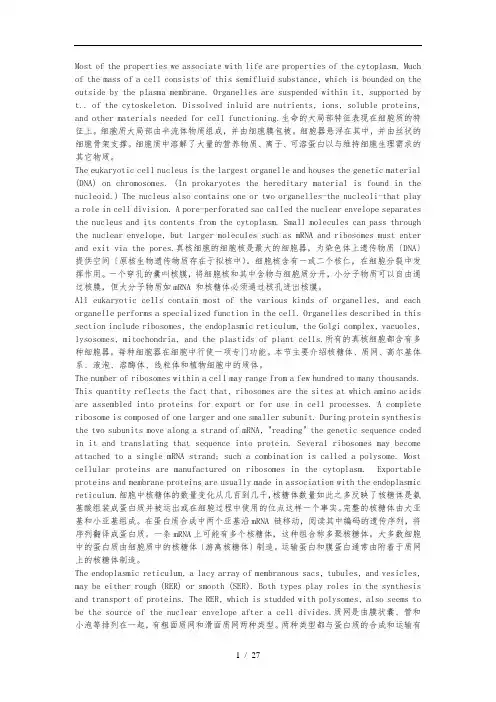
Most of the properties we associate with life are properties of the cytoplasm. Much of the mass of a cell consists of this semifluid substance, which is bounded on the outside by the plasma membrane. Organelles are suspended within it, supported by t.. of the cytoskeleton. Dissolved inluid are nutrients, ions, soluble proteins, and other materials needed for cell functioning.生命的大局部特征表现在细胞质的特征上。
细胞质大局部由半流体物质组成,并由细胞膜包被。
细胞器悬浮在其中,并由丝状的细胞骨架支撑。
细胞质中溶解了大量的营养物质、离子、可溶蛋白以与维持细胞生理需求的其它物质。
The eukaryotic cell nucleus is the largest organelle and houses the genetic material (DNA) on chromosomes. (In prokaryotes the hereditary material is found in the nucleoid.) The nucleus also contains one or two organelles-the nucleoli-that play a role in cell division. A pore-perforated sac called the nuclear envelope separates the nucleus and its contents from the cytoplasm. Small molecules can pass through the nuclear envelope, but larger molecules such as mRNA and ribosomes must enter and exit via the pores.真核细胞的细胞核是最大的细胞器,为染色体上遗传物质〔DNA〕提供空间〔原核生物遗传物质存在于拟核中〕。

Most of the properties we associate with life are properties of the cytoplasm. Much of the mass of a cell consists of this semifluid substance, which is bounded on the outside by the plasma membrane. Organelles are suspended within it, supported by t.. of the cytoskeleton. Dissolved inluid are nutrients, ions, soluble proteins, and other materials needed for cell functioning.生命的大部分特征表现在细胞质的特征上。
细胞质大部分由半流体物质组成,并由细胞膜包被。
细胞器悬浮在其中,并由丝状的细胞骨架支撑。
细胞质中溶解了大量的营养物质、离子、可溶蛋白以及维持细胞生理需求的其它物质。
The eukaryotic cell nucleus is the largest organelle and houses the genetic material (DNA) on chromosomes. (In prokaryotes the hereditary material is found in the nucleoid.) The nucleus also contains one or two organelles-the nucleoli-that play a role in cell division. A pore-perforated sac called the nuclear envelope separates the nucleus and its contents from the cytoplasm. Small molecules can pass through the nuclear envelope, but larger molecules such as mRNA and ribosomes must enter and exit via the pores.真核细胞的细胞核是最大的细胞器,为染色体上遗传物质(DNA)提供空间(原核生物遗传物质存在于拟核中)。

生物专业英语——蒋悟生编第三版(Lesson One~Lesson Ten)河南科技大学食品与生物工程学院生物工程111班Lesson one:Inside the Living Cell:Structure andFunction of Internal Cell PartsCytoplasm:The Dynamic,Mobile Factory细胞质:动力工厂Most of the properties we associate with life are properties of the cytoplasm.Much of the mass of a cell consists of this semifluid substance,which is bounded on the outside by the plasma anelles are suspended within it,supported by the filamentous network of the cytoskeleton.Dissolved in the cytoplasmic fluid are nutrients,ions,soluble proteins,and other materials needed for cell functioning.生命的大部分特征表现在细胞质的特征上。
细胞质大部分由半流体物质组成,并由细胞膜(原生质膜)包被。
细胞器悬浮在其中,并由丝状的细胞骨架支撑。
细胞质中溶解了大量的营养物质,离子,可溶蛋白以及维持细胞生理需求的其它物质。
The Nucleus:Information Central(细胞核:信息中心)The eukaryotic cell nucleus is the largest organelle and houses the genetic material(DNA)on chromosomes. (In prokaryotes the hereditary material is found in the nucleoid.)The nucleus also contains one or two organelles-the nucleoli-that play a role in cell division.A pore-perforated sac called the nuclear envelope separates the nucleus and its contents from the cytoplasm.Small molecules can pass through the nuclear envelope,but larger molecules such as mRNA and ribosomes must enter and exit via the pores.真核细胞的细胞核是最大的细胞器,细胞核对染色体组有保护作用(原核细胞的遗传物质存在于拟核中)。

生物专业英语翻译+蒋悟生+第3版------------------------------------------作者------------------------------------------日期Lesson One(4学时)Inside the Living Cell: Structure andFunction of Internal Cell Parts1.Cytoplasm: The Dynamic, Mobile Factory细胞质:动力工厂Most of the properties we associate with life are properties of the cytoplasm. Much of the mass of a cell consists of this semifluid substance, which is bounded on the outside by the plasma membrane. Organelles are suspended within it, supported by the filamentous network of the cytoskeleton. Dissolved in the cytoplasmic fluid are nutrients, ions, soluble proteins, and other materials needed for cell functioning.生命的大部分特征表现在细胞质的特征上。
细胞质大部分由半流体物质组成,并由细胞膜(原生质膜)包被。
细胞器悬浮在其中,并由丝状的细胞骨架支撑。
细胞质中溶解了大量的营养物质,离子,可溶蛋白以及维持细胞生理需求的其它物质。
2.The Nucleus: Information Central(细胞核:信息中心)The eukaryotic cell nucleus is the largest organelle and houses the genetic material (DNA) on chromosomes. (In prokaryotes the hereditary material is found in the nucleoid.) The nucleus also contains one or two organelles-the nucleoli-that play a role in cell division. A pore-perforated sac called the nuclear envelope separates the nucleus and its contents from the cytoplasm. Small molecules can pass through the nuclear envelope, but larger molecules such as mRNA and ribosomes must enter and exit via the pores.真核细胞的细胞核是最大的细胞器,细胞核对染色体组有保护作用(原核细胞的遗传物质存在于拟核中)。
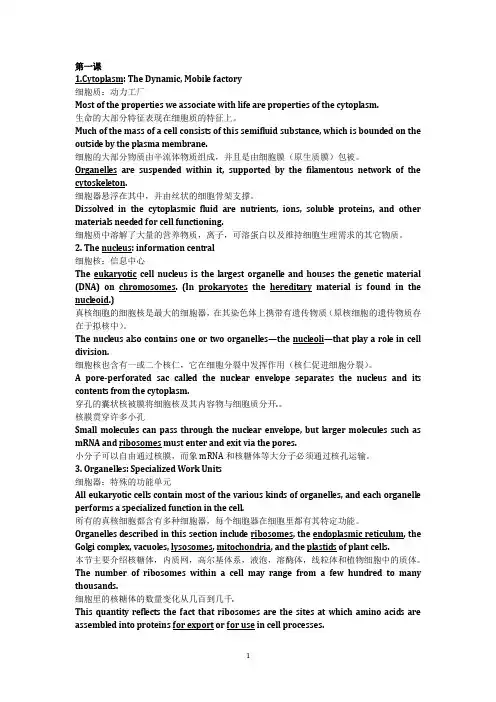
第一课1.Cytoplasm: The Dynamic, Mobile factory细胞质:动力工厂Most of the properties we associate with life are properties of the cytoplasm.生命的大部分特征表现在细胞质的特征上。
Much of the mass of a cell consists of this semifluid substance, which is bound ed on the outsid e by the plasma membrane.细胞的大部分物质由半流体物质组成,并且是由细胞膜(原生质膜)包被。
Organell es are suspend ed within it, supported by the filamentous network of the cytoskeleton.细胞器悬浮在其中,并由丝状的细胞骨架支撑。
Dissolved in the cytoplasmic fluid are nutrients, ions, solubl e proteins, and other materials need ed for cell functioning.细胞质中溶解了大量的营养物质,离子,可溶蛋白以及维持细胞生理需求的其它物质。
2. The nucl eus: information central细胞核:信息中心The eukaryotic cell nucl eus is the largest organelle and houses the genetic material (DNA) on chromosomes. (In prokaryotes the hereditary material is found in the nucl eoid.)真核细胞的细胞核是最大的细胞器,在其染色体上携带有遗传物质(原核细胞的遗传物质存在于拟核中)。

生物专业英语翻译+蒋悟生+第3版------------------------------------------作者------------------------------------------日期Lesson One(4学时)Inside the Living Cell: Structure andFunction of Internal Cell Parts1.Cytoplasm: The Dynamic, Mobile Factory细胞质:动力工厂Most of the properties we associate with life are properties of the cytoplasm. Much of the mass of a cell consists of this semifluid substance, which is bounded on the outside by the plasma membrane. Organelles are suspended within it, supported by the filamentous network of the cytoskeleton. Dissolved in the cytoplasmic fluid are nutrients, ions, soluble proteins, and other materials needed for cell functioning.生命的大部分特征表现在细胞质的特征上。
细胞质大部分由半流体物质组成,并由细胞膜(原生质膜)包被。
细胞器悬浮在其中,并由丝状的细胞骨架支撑。
细胞质中溶解了大量的营养物质,离子,可溶蛋白以及维持细胞生理需求的其它物质。
2.The Nucleus: Information Central(细胞核:信息中心)The eukaryotic cell nucleus is the largest organelle and houses the genetic material (DNA) on chromosomes. (In prokaryotes the hereditary material is found in the nucleoid.) The nucleus also contains one or two organelles-the nucleoli-that play a role in cell division. A pore-perforated sac called the nuclear envelope separates the nucleus and its contents from the cytoplasm. Small molecules can pass through the nuclear envelope, but larger molecules such as mRNA and ribosomes must enter and exit via the pores.真核细胞的细胞核是最大的细胞器,细胞核对染色体组有保护作用(原核细胞的遗传物质存在于拟核中)。
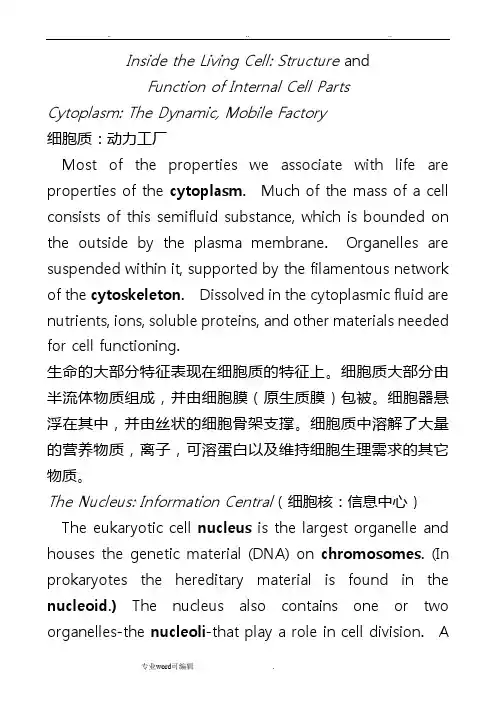
Inside the Living Cell: Structure andFunction of Internal Cell Parts Cytoplasm: The Dynamic, Mobile Factory细胞质:动力工厂Most of the properties we associate with life are properties of the cytoplasm. Much of the mass of a cell consists of this semifluid substance, which is bounded on the outside by the plasma membrane. Organelles are suspended within it, supported by the filamentous network of the cytoskeleton. Dissolved in the cytoplasmic fluid are nutrients, ions, soluble proteins, and other materials needed for cell functioning.生命的大部分特征表现在细胞质的特征上。
细胞质大部分由半流体物质组成,并由细胞膜(原生质膜)包被。
细胞器悬浮在其中,并由丝状的细胞骨架支撑。
细胞质中溶解了大量的营养物质,离子,可溶蛋白以及维持细胞生理需求的其它物质。
The Nucleus: Information Central(细胞核:信息中心)The eukaryotic cell nucleus is the largest organelle and houses the genetic material (DNA) on chromosomes. (In prokaryotes the hereditary material is found in the nucleoid.) The nucleus also contains one or two organelles-the nucleoli-that play a role in cell division. Apore-perforated sac called the nuclear envelope separates the nucleus and its contents from the cytoplasm. Small molecules can pass through the nuclear envelope, but larger molecules such as mRNA and ribosomes must enter and exit via the pores.真核细胞的细胞核是最大的细胞器,细胞核对染色体组有保护作用(原核细胞的遗传物质存在于拟核中)。
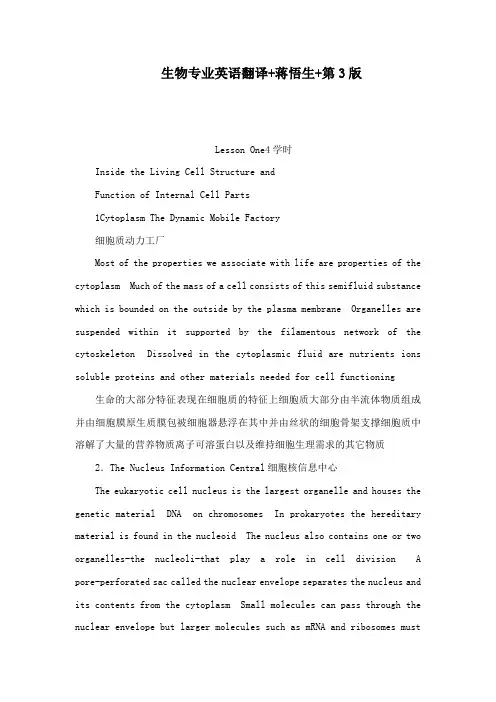
生物专业英语翻译+蒋悟生+第3版Lesson One4学时Inside the Living Cell Structure andFunction of Internal Cell Parts1Cytoplasm The Dynamic Mobile Factory细胞质动力工厂Most of the properties we associate with life are properties of the cytoplasm Much of the mass of a cell consists of this semifluid substance which is bounded on the outside by the plasma membrane Organelles are suspended within it supported by the filamentous network of the cytoskeleton Dissolved in the cytoplasmic fluid are nutrients ions soluble proteins and other materials needed for cell functioning 生命的大部分特征表现在细胞质的特征上细胞质大部分由半流体物质组成并由细胞膜原生质膜包被细胞器悬浮在其中并由丝状的细胞骨架支撑细胞质中溶解了大量的营养物质离子可溶蛋白以及维持细胞生理需求的其它物质2.The Nucleus Information Central细胞核信息中心The eukaryotic cell nucleus is the largest organelle and houses the genetic material DNA on chromosomes In prokaryotes the hereditary material is found in the nucleoid The nucleus also contains one or two organelles-the nucleoli-that play a role in cell division A pore-perforated sac called the nuclear envelope separates the nucleus and its contents from the cytoplasm Small molecules can pass through the nuclear envelope but larger molecules such as mRNA and ribosomes mustenter and exit via the pores真核细胞的细胞核是最大的细胞器细胞核对染色体组有保护作用原核细胞的遗传物质存在于拟核中细胞核含有一或二个核仁核仁促进细胞分裂核膜贯穿许多小孔小分子可以自由通过核膜而象mRNA和核糖体等大分子必须通过核孔运输3Organelles Specialized Work Units细胞器特殊的功能单位All eukaryotic cells contain most of the various kinds of organelles and each organelle performs a specialized function in the cell Organelles described in this section include ribosomes the endoplasmic reticulum the Golgi complex vacuoles lysosomes mitochondria and the plastids of plant cells所有的真核细胞都含有多种细胞器每个细胞器都有其特定功能本节主要介绍核糖体内质网高尔基体系液泡溶酶体线粒体和植物细胞中的质体The number of ribosomes within a cell may range from a few hundred to many thousands This quantity reflects the fact that ribosomes are the sites at which amino acids are assembled into proteins for export or for use in cell processes A complete ribosome is composed of one larger and one smaller subunit During protein synthesis the two subunits move along a strand of mRNA "reading" the genetic sequence coded in it and translating that sequence into protein Several ribosomes may become attached to a single mRNA strand such a combination is called a polysome Most cellular proteins are manufactured on ribosomes in the cytoplasm Exportable proteins and membrane proteins are usually made in association with the endoplasmic reticulum核糖体的数量变化从几百到几千核糖体是氨基酸组装成蛋白质的重要场所完整的核糖体由大亚基和小亚基组成核糖体沿着mRNA移动并阅读遗传密码翻译成蛋白质一条mRNA上可能有多个核糖体称多聚核糖体大多数细胞蛋白是由细胞质中核糖体生产输出蛋白和膜蛋白通常与内质网有关The endoplasmic reticulum a lacy array of membranous sacs tubules and vesicles may be either rough RER or smooth SER Both types play roles in the synthesis and transport of proteins The RER which is studded with polysomes also seems to be the source of the nuclear envelope after a cell divides内质网带有花边的生物囊有管状泡状之分以及光滑和粗糙面区别两种都与蛋白质的合成和运输有关粗糙内质网上分布许多核糖体也可能提供细胞分裂后所需的细胞膜SER lacks polysomes it is active in the synthesis of fats and steroids and in the oxidation of toxic substances in the cell Both types of endoplasmic reticulum serve as compartments within the cell where specific products can be isolated and subsequently shunted to particular areas in or outside the cell光滑内质网上无核糖体主要作用是脂肪和类固醇的合成以及细胞内有毒物质的氧化两种内质网合成的产物在其中进行分流或运输到细胞外Transport vesicles may carry exportable molecules from the endoplasmic reticulum to another membranous organelle the Golgi complex Within the Golgi complex molecules are modified and packaged for export out of the cell or for delivery else where in the cytoplasm 运输小泡能够将可运输分子从内质网运输到高尔基复合体上在高尔基复合体中修饰包装后输出细胞或传递到细胞质中的其他场所Vacuoles in cells appear to be hollow sacs but are actually filledwith fluid and soluble molecules The most prominent vacuoles appear in plant cells and serve as water reservoirs and storage sites for sugars and other molecules Vacuoles in animal cells carry out phagocytosis the intake of particulate matter and pinocytosis vacuolar drinking 细胞中的液泡好象是中空的但实际上充满了液体和可溶分子最典型的液泡存在于植物细胞中储备水糖以及其它分子动物中的液泡起吞噬和胞饮作用A subset of vacuoles are the organelles known as lysosomes which contain digestive enzymes packaged in lysosomes in the Golgi complex that can break down most biological macromolecules They act to digest food particles and to degrade damaged cell parts溶酶体是液泡亚单位含有消化酶降解大部分生物大分子消化食物微粒和降解损伤的细胞残片Mitochondria are the sites of energy-yielding chemical reactions in all cells In addition plant cells contain plastids that utilize light energy to manufacture carbohydrates in the process of photosynthesis It is on the large surface area provided by the inner cristae of mitochondria that ATP-generating enzymes are located Mitochondria are self-replicating and probably they are the evolutionary descendants of what were once free-living prokaryotes线粒体是细胞中化学产能的场所另外植物细胞中的质体在光合作用中利用光能产生碳水化合物线粒体内嵴上提供了很大的表面积并分布着产ATP酶线粒体自我复制并且可能是自由生活的原核生物在进化中形成的后代There are two types of plastids leucoplasts which lack pigments and serve as storage sites for starch proteins and oils and chromoplasts which contain pigments The most important chromoplasts arechloroplasts-organelles that contain the chlorophyll used in photosynthesis The internal structure of chloroplasts includes stacks of membranes called grana which are embedded in a matrix called the stroma 质体有两种类型白色体缺乏色素是淀粉蛋白质和油的储备场所色质体含有色素叶绿体是最重要的色质体含有与光合作用有关的叶绿素叶绿体的内部结构是由多层膜形成的叶绿体基粒其中包埋在基质中的基粒称子座4The Cytoskeleton细胞骨架All eukaryotic cells have a cytoskeleton which is a convoluted latticework of filaments and tubules that appears to fill all available space in the cell and provides support for various other organelles A large portion of the cytoskeleton consists of threadlike microfilaments composed mainly of the contractile protein actin They are involved in many types of intracellular movements in plant and animal cells A second protein myosin is involve in the contraction of muscle cells Another main structural component of the cytoskeleton consists of microtubules which are composed of the globular protein tubulin and together act as scaffolding that provides a stable cell shape Cytoskeletal intermediate filaments appear to impart tensile strength to the cell cytoplasm Mechanoenzymes such as myosin dynein and kinesin interact with the cytoskeletal filaments and tubules to generate forces that cause movements所有的细胞都有细胞骨架网络结构的纤丝充满了它所能触及的全部空间并且对细胞器提供支持作用细胞骨架大部分由微丝组成微丝主要由可收缩的肌动蛋白组成动植物细胞的许多种类型细胞内运动与肌动蛋白有关第二类蛋白是肌球蛋白它与肌肉细胞的收缩有关细胞骨架的另一个主要结构成分是微管由球状的微管蛋白组成象脚手架一般维持细胞的稳定形态细胞骨架的中间丝提供了细胞质伸缩动力机械酶例如肌球蛋白动力蛋白驱动蛋白与微丝微管相互作用产生动力而引起细胞运动5Cellular Movements细胞运动Although the cytoskeleton provides some stability稳固 to cells its microtubules英[maikrutjubjul] and filaments 丝状物and their associated proteins enable cells to move by creeping 爬行 or gliding 滑动 Such movements require a solid固体的 substrate to which the cell can adhere 附着 and can be guided by the geometry dimitri] 几何形状of the surface Some cells also exhibit [iɡzibit] 展览 chemotaxis kemtksis趋药性 the ability to move toward or away from the source of a diffusing 扩散chemicalCertain eukaryotic cells can swim freely in liquid environments propelled by whiplike cilia [sili]纤毛or flagella 英[fldel鞭毛 Both cilia and flagella have the same internal structure nine doublets pairs of microtubules are arranged in a ring and extend the length of the cilium or flagellum and two more microtubules run down the center of the ring Every cilium or flagellum grows only from the cell surface where a basal body基体is located Movement is based on the activities of tiny dynein 动力蛋白 side arms that extend from one of the microtubules of each doublet成对的东西Nutrients proteins and other materials within most plant cells are moved about via cytoplasmic streaming The process occurs as myosin maiusin肌凝蛋白 proteins attached to organelles 细胞器小器官 push against microfilaments arrayed [rei] 展示throughout the cell Microfilaments and microtubules are responsible for almost all majorcytoplasmic movements During cell division microtubules of the spindle assembled 集合收集from tubutin subunits near organelles called centrioles move the chromosomesLesson Two2学时PhotosynthesisPhotosynthesis occurs only in the chlorophyllchlorophyll叶绿素-containing cells of green plants algae藻 and certain protists 原生生物and bacteria Overall it is a process that converts light energy into chemical energy that is stored in the molecular bonds From the point of view of chemistry and energetics it is the opposite of cellular respiration Whereas 然而 cellular细胞的 respiration 呼吸is highly exergonic吸收能量的and releases energy photosynthesis光合作用requires energy and is highly endergonic光合作用只发生在含有叶绿素的绿色植物细胞海藻某些原生动物和细菌之中总体来说这是一个将光能转化成化学能并将能量贮存在分子键中从化学和动能学角度来看它是细胞呼吸作用的对立面细胞呼吸作用是高度放能的光合作用是需要能量并高吸能的过程Photosynthesis starts with CO2 and H2O as raw materials and proceeds through two sets of partial reactions In the first set called the light-dependent reactions water molecules are split裂开 oxidized 02 is released and ATP and NADPH are formed These reactions must take place in the presence of 在面前light energy In the second set called light-independent reactions CO2 is reduced via the addition of H atoms to carbohydrate These chemical events rely on the electron carrier NADPH and ATP generated by the first set of reactions光合作用以二氧化碳和水为原材料并经历两步化学反应第一步称光反应水分子分解氧分子释放ATP和NADPH形成此反应需要光能的存在第二步称暗反应二氧化碳被还原成碳水化合物这步反应依赖电子载体NADPH以及第一步反应产生的ATPBoth sets of reactions take place in chloroplasts Most of the enzymes and pigments 色素for the lightdependent reactions are embedded 深入的内含的in the thylakoid类囊体 membrane膜隔膜 of chloroplasts 叶绿体The dark reactions take place in the stroma基质两步反应都发生在叶绿体中光反应需要的大部分酶和色素包埋在叶绿体的类囊体膜上暗反应发生在基质中How Light Energy Reaches Photosynthetic Cells光合细胞如何吸收光能的The energy in light photons in the visible part of the spectrum can be captured by biological molecules to do constructive work The pigment chlorophyll in plant cells absorbs photons within a particular absorption spectrums statement of the amount of light absorbed by chlorophyll at different wavelengths When light is absorbed it alters the arrangement of electrons in the absorbing molecule The added energy of the photon boosts the energy condition of the molecule from a stable state to a less-stable excited state During the light-dependent reactions of photosynthesis as the absorbing molecule returns to the ground state the "excess" excitation energy is transmitted to other molecules and stored as chemical energy生物分子能捕获可见光谱中的光能植物细胞中叶绿素在不同光波下吸收部分吸收光谱在吸收分子中光的作用使分子中的电子发生重排光子的能量激活了分子的能量状态使其从稳定态进入不稳定的激活态All photosynthetic organisms contain various classes of chlorophylls and one or more carotenoid accessory pigments that also contribute tophotosynthesis Groups of pigment molecules called antenna complexes are present on thylakoids Light striking any one of the pigment molecules is funneled to a special chlorophyll a molecule termed a reaction-center chlorophyll which directly participates in photosynthesis Most photosynthetic organisms possess two types of reaction-center chlorophylls P680 and P700 each associated with an electron acceptor molecule and an electron donor These aggregations are known respectively as photosystem Ⅰ P700 and photosystem Ⅱ P680所有的光合作用生物含有不同等级的叶绿素和一个或多个类胡萝卜素光合作用的辅助色素称作天线复合体的色素分子群存在于类囊体中激活色素分子的光能进入叶绿素反应中心其直接参与光合作用大部分光反应细胞器拥有两套反应中心P680和P700每个光系统都含有一个电子受体和电子供体这些集合体就是大家熟识的光合系统Ⅰ和光合系统ⅡThe Light-Dependent Reaction Converting Solar Energy into Chemical-Bond Energy光反应光能转化成化学键能The photosystems of the light-dependent reactions are responsible for the packaging of light energy in the chemical compounds ATP and NADPH This packaging takes place through a series of oxidation reduction reactions set in motion when light strikes the P680 reaction center in photosystem Ⅱ In this initial event water molecules are cleaved oxygen is released and electrons are donated These electrons are accepted first by plastoquinone and then by a series of carriers as they descend an electron transport chain For each four electrons that pass down the chain two ATPs are formed The last acceptor in the chain is the P700 reactioncenter of photosystem Ⅰ At this point incoming photons boost the energy of the electrons and they are accepted by ferredoxin Ferredoxin is then reoxidized and the coenzyme NADP is reduced to the NADPH The ATP generated previously and the NADPH then take part in the light independent reactions光反应的光系统将光能转化成化学复合物ATP和NADPH当光激活光系统Ⅱ的光反应中心时通过一系列的氧化还原反应实现能量的传递反应开始时水被分解氧被释放并提供电子电子首先传递给质体醌然后通过一系列载体形成的电子传递链每传递4个电子形成2个ATP最后一个受体存在于光反应系统Ⅰ的反应中心里此处光子激活电子电子传递给铁氧还蛋白铁氧还蛋白再氧化并且辅酶NADP还原成NADPH早期产生的ATP和NADPH进入暗反应The production of ATP from the transport of electrons excited by light energy down an electron transport chain is termed photophosphorylation The one-way flow of electrons through photosystems II and I is called noncyclic photophosphorylation plants also derive additional ATP through cyclic photophosphorylation in which some electrons are shunted back through the electron transport chain between photosystems Ⅱ and Ⅰ由电子传递链偶连产生ATP的过程称为光合磷酸化通过光合系统Ⅱ流经光合系统Ⅰ的电子路径称非循环式光合磷酸化植物通过循环式光合磷酸化获得额外的ATP一些电子在光合系统Ⅰ和Ⅱ之间的电子传递链中回流The Light-Independent Reactions Building Carbohydrates暗反应碳水化合物的形成In the light-independent reactions of photosynthesis which are driven by ATP and NADPH C02 is converted to carbohydrate The reactions are also known as the Calvin-Benson cycle Atmospheric CO2 is fixed as it reactswith ribulose biphosphate RuBP a reaction that is catalyzed by the enzyme ribulose biphosphate carboxylase The reduction Of C02 to carbohydrate fructose diphosphate is completed via several more steps of the cycle Finally RUBP is regenerated so that the cycle may continue 由ATP和NADPH驱动的暗反应中二氧化碳转化成碳水化合物即卡尔文循环二磷酸核酮糖固定二氧化碳由二磷酸核酮糖羧化酶催化Oxygen An Inhibitor of photosynthesis氧光合作用的抑制因子High levels of oxygen in plant cells can disrupt photosynthesis and can also cause photorespiration-an inefficient fun of the dark reactions in which 02 is fixed rather than C02 and no carbohydrate is produced Reprieve from Photorespiration The C4 PathwayMost plants are C3 plants they experience decreased carbohydrate production under hot dry conditions as a result of the effects of photorespiration Among C4 plants however special leaf anatomy and a unique biochemical pathway enable the plant to thrive in and conditions Thus C4 plants lessen photorespiration by carrying out photosynthesis only in cells that are insulated from high levels of CO2 They also possess a novel mechanism for carbon fixation大部分植物是碳3植物在高温干旱条件下由于光呼吸作用而使碳水化合物的合成降低而在大多数的碳4植物中由于叶脉的特殊构造和独特的化学路径使植物依然很茂盛这是碳固定的一个新机制课后作业第一篇阅读材料答案1B2A3A4D5C6cLesson Three2学时Cellular Reproduction Mitosis and MeiosisThe Nucleus and ChromosomesThe cell nucleus is the main repository of genetic information Within the nucleus are the chromosomes tightly coiled strands of DNA and clusters of associated proteins Long stretches of the continuous DNA molecule wind around these clusters of proteins or histones forming beadlike complexes known as nucleosomes More coiling and supercoiling produces a dense chromosome structure Each long strand of DNA combines with histones and nonhistone proteins to make up the substance chromatin 细胞核是贮藏遗传信息的主要场所DNA盘绕成螺旋线以及相关的成簇蛋白质DNA螺旋线缠绕成簇的组蛋白形成珠链状的核小体这些螺旋和超螺旋形成致密的染色体组结构每个长链DNA与组蛋白和非组蛋白一起构成染色质物质A pictorial display of an organisms chromosomes in the coiled condensed state is known as a karyotype Karyotype reveal that in most cells all but sex chromosomes are present as two copies referred to as homologous pairs Non-sex chromosomes are called autosomes Organisms whose cells contain two sets of parental chromosomes are called diploid those with cells containing a single set of parental chromosomes are called haploid染色体致密的超螺旋状态我们称染色体组除了性染色体外大多数细胞的染色体组成对出现称同源染色体对非性染色体称常染色体生物细胞含有两套父母本染色体的称二倍体含有单套染色体的称单倍体The Cell CycleThe cell cycle is a regular sequence in which the cell grows prepares for division and divides to form two daughter cells each of which thenrepeats the cycle Such cycling in effect makes single-celled organisms immortal Many cells in multicellular organisms including animal muscle and nerve cells either slow the cycle or break out of it altogether 在细胞生长过程中细胞循环遵循特定程序分裂准备分裂成2个子细胞子细胞再循环此循环使得单细胞永生多细胞生物中的许多细胞包括动物肌肉和神经细胞要么降低循环速度要么同时分裂The normal cell cycle consists of four phases The first three include G1 the period of normal metabolism S phase during which normal synthesis of biological molecules continues DNA is replicated and histones are synthesized and G2 a brief period of metabolism and additional growth Together the G1 S and G2 phases are called interphase The fourth phase of the cell cycle is M phase the period of mitosis during which the replicated chromosomes condense and move and the cell divides It is believed that properties of the cell cytoplasm control the cell cycle along with external stimulators and inhibitors such as chalones 正常细胞循环由4个时期组成头三期包括G1正常新陈代谢S期正常新陈代谢同时DNA复制组蛋白合成 G2 期短期的新陈代谢和少许生长G1 S 和G2称分裂间期最后是M期有丝分裂期复制的染色体组浓缩移动并细胞分裂据称是染色质控制了细胞循环伴随外部激活因子和抑制因子如抑素Mitosis Partitioning the Hereditary MaterialBiologists divide the mitotic cycle into four phases At the beginning of prophase 前期 the chromosomes each consist of two highly condensed chromatids attached to each other at a centromere As prophase ends and metaphase 中期 begins the condensed 浓缩的 chromosomes become associated with the spindle 纺锤体 Eventually the chromosomes becomearranged in a plane called the metaphase plate at a right angle to the spindle fibers Next during anaphase 后期 the two sister chromatids of each chromosome split and one from each pair is drawn toward each pole of the cell During telophase 末期 nuclear envelopes 包膜 begin to form around each set of chromosomes and division of the cytoplasm takes place 生物学家将有丝分裂划分为4个阶段分裂前期高度浓缩的两个染色单体通过着丝粒连接在一起在分裂前期后期和分裂中期前期浓缩的染色体与纺锤体相连最后以正确的角度排列在赤道板上在分裂后期两个姊妹单体分离分别拽向细胞两极在分裂末期在每套染色体周围形成核膜细胞质发生分裂As mitosis proceeds the spindle microtubules play a crucial role in ensuring that both paired and separated chromatids 染色单体 move in the right directions at the proper times Each half of the spindle forms as microtubules extend from each pole of a dividing cell to the region of the metaphase plate During prophase other microtubules the centromeric 着丝粒fibers extend outward from the spindle poles to structures on the chromosomes called kinetochores着丝粒 During anaphase the fibers begin to shorten and the chromatids begin to move apart在有丝分裂过程中是纺锤体微管确保了染色单体在适当时间以正确方向进行分离纺锤体微管由两极向赤道板延伸在分裂前期其它微管着丝粒纤维延伸到染色体的动粒在分裂后期纤维开始变短染色单体分离The spindle forms differently in plant and animal cells In animals it is associated with centriole 中心粒 while in plant and fungal 真菌cells spindle formation is associated with reions called microtubule organizing centers植物和动物细胞形成的纺锤体不同动物细胞与中心粒相连而在植物和真菌细胞中纺锤体与微管组织中心的离子相连Cytokinesis Partitioning the Cytoplasm胞质分裂细胞质分离The division of the cell cytoplasm at the end of mitosis is called cytokinesis 细胞浆移动 In animal cells it takes place as a ring of actin filaments contracts使缩短合同契约around the cell equator赤道pinching收聚 the cell in two In plant cells which are bounded 有限制的 by a cell wall cytokinesis involves the building of a new cell plate across the dividing cell at its equator Cell wall material is then deposited 存放堆积 in the region of the cell plate在动物细胞中环形肌动蛋白丝延赤道板收缩而使细胞一分为二在植物细胞中在赤道板形成新的细胞板Meiosis The Basis of Sexual ReproductionMeiosis 减数 is a special form of cell division that takes place in the reproductive 生殖 organs that produce sex cells Like mitosis it takes place after DNA replication has occurred and involves two sequential 连续的 nuclear divisions meiosis I and meiosis Ⅱ These divisions result in four daughter cells each with half the number of chromosomes of the parent cell The phenomenon of crossing over during meiosis results in exchanges of genetic information between chromosomes Hence因此 the homologous 同源的 chromosomes distributed 分布 to different progeny 后裔 cells are not identical同样的减数分裂是性细胞分裂的特殊形式如有丝分裂它也是发生在DNA复制后并有连续的两个核分裂产生4个子细胞分别含有亲本一半的染色体数As in mitosis two chromatids exist for each chromosome at thebeginning of prophase 1 During this phase the homologous 同源 chromosomes undergo 经历sy-napsis 联会 or pairing which is brought about by a bridging structure of proteins and RNA called the synaptonemal 联会丝的 complex The homologous pairs stay together when they align on the metaphase 中plate Unlike the anaphase of mitosis however during anaphase I the two chromatids of each chromosome stay joined at the centromere 着丝点 and move together to one of the two poles of the cell It is this event that results in the halving 减半的 of the chromosome number in the four daughter cells that result from meiosis 正如在有丝分裂中一样两个同源染色单体通过蛋白质和RNA桥配对形成联会复合体与有丝分裂不同的是每组染色体的两个染色单体连接在着丝点上并一起移向细胞两极的一级由此而导致4个子细胞染色体数减半During telophase末期 I nuclear envelopes enclose the chromosomes in nuclei and in most species cytokinesis 细胞浆流动 the first nuclear division follows The second nuclear division begins with metaphase Ⅱin which the chromosomes in each daughter cell again align 排列on a metaphase plate The centromeres着丝粒 finally divide and each sister chromatid moves to one of the poles of the spindle The next phase is telophase followed again by cytokinesis The result of the entire process is four haploid cells in which parental chromosomes are randomly distributed第二次核分裂开始于分裂中期子细胞中染色体重新排列在赤道板上着丝粒最终分离每个姊妹染色单体分向两极接着胞质分裂产生4个单倍体父母染色体随机分配Asexual Versus Sexual ReproductionMitosis and meiosis respectively分别 make simple cell division and sexual reproduction possible Each means of passing on hereditary 遗传information has advantages In asexual 无性的 reproduction the parent organism生物体 gives rise to offspring 后代that are genetic clones of the parent The advantages of this type of reproduction are that it preserves the parents successful genetic complement 遗传互补 requires little or no specialization of reproductive organs and is more rapid than sexual reproduction A major disadvantage of the asexual mode is that a single catastrophic灾难的event or disease may destroy an entire population of genetically identical organisms A prime benefit of sexual reproduction is that it provides genetic variability and a ready mechanism 机制 for the elimination of deleterious mutations It also allows "new" gene forms to arise and spread through populations有丝分裂和减数分裂在传递遗传信息过程中各有优势体细胞的繁殖就是父母本的克隆其优势是保留了父母本的成功遗传信息不需要特殊器官比性复制快的多但一个简单灾难性事件或疾病都可能摧毁一个细胞群体性复制的优势是它提供了遗传可变性和现存排除有害突变的机制也可以产生新的基因并在种群中蔓延课后作业第一篇阅读材料答案1C2B3D4B5A6DLesson Four2学时Foundations of GeneticsEarly Theories of inheritaneeEarly ideas of inheritance included Hippocrates theory of pangenesis and August Weismands germ plasm theory Based on experiments with miceWeismann proposed that hereditary information in gametes transmitted traits to progeny Both of these early views incorporated the blending theory they held that heritable traits of the two parents blend so that the distinct characteristics of each are lost in offspring遗传学的早期理论包括泛生说和种质理论基于小鼠实验维丝曼提出遗传信息储存在配子中并将遗传信息传递给后代这两个早期观点合起来形成融合理论子代拥有父母本混合的遗传特征而不完全象亲代Gregor Mendel and the Birth of GeneticsGregor Mendel an Augustinian monk in the monastery at Brunn Austria is known as the "father of genetics" Having been exposed to theories of the particulate nature of matter while a university student and having a background in mathematics Mendel carried out a series of carefully planned experiments that demonstrated the particulate nature of heredity His revolutionary ideas were neither understood nor accepted until many years after Mendel died孟德尔众所周知的遗传学之父是一名修道士当他还是大学生时就提出了物质的粒子属性孟德尔进行了一系列周密安排的实验来证实遗传的颗粒性直到他去世后他的理论才被理解和接受Mendels Classic ExperimentsMendel studied genetics through plant-breeding experiments with the garden pea a plant species that is self-fertilizing and breeds true each offspring is identical to the parent in the trait of interest To test the blending theory he focused his research on seven distinct characters Each of these characters such as seed color and plant height present only two clear-cut possibilities He also recorded the type and number of allprogeny produced from each pair of parent pea plants and followed the results of each cross for two generations孟德尔通过豌豆实验研究遗传学豌豆是自花授粉植物和纯品系为验证融合理论他的研究主要集中在7个特征上例如种子颜色植株高度这些特征只有两个明确的可能性他记录了产生的每一个子代类型和数量在杂交产生子2代For each of the characters he studied Mendel found that one trait was dominant while the other was recessive In the second filial F2 generation the ratio of dominant to recessive was 31 Mendel deduced that this result was possible only if each individual possesses only two hereditary units one from each parent The units Mendel hypothesized are today known as alleles alternative forms of genes Genes are the basic units of heredity An organism that inherits identical alleles for a trait from each parent is said to be homozygous for that trait if different alleles for a trait are inherited the organism is heterozygous for that trait When an organism is heterozygous for a trait the resulting phenotype for that trait expresses only the dominant alleleThus the organisms phenotypeits physical appearance and properties-differs from its genotype which may include both a dominant and a recessive allele A pictorial representation of all possible combinations of a genetic cross is known as a Punnett square对于每个特征而言要么显形要么隐性在子2代中显形与隐性比为3∶1只有在每个个体仅拥有两个研究遗传单元并每个单元来自一个亲代时实验结果才成立此遗传单元就是今天共识的等位基因两个一样的等位基因决定一个特征称纯合相反称杂合当生物是杂合时它的表型由显性基因决定因此生物的表型与基因型是不同的旁纳特方格可以陈列所有可能的遗传组合The results of Mendels experiments on dominant and recessive inheritance let to Mendels first law the law of segregationThis law states that for a given trait an organism inherits one allele from each parent Together these alleles form the allele pair When gametes are formed during meiosis the two alleles become separated halving of chromosome number To gain evidence for his theory Mendel performed test crosses mating plants of unknown genotype to plants that were homozygous recessive for the trait of interest The ratio of dominant phenotypes if any in the progeny makes clear whether the unknown genotype is heterozygous homozygous dominant or homozygous recessive分离定律生物只遗传父母本等位基因对的一个等位基因减数分裂期形成配子时两个等位基因分离为验证此理论他做了测交实验即基因型未知的植物与纯合的隐性基因植物杂交子代显性表型可以明确测得杂合基因或纯合基因的基因型Mendels Ideas and the Law of independent AssortmentMendel also performed dihybrid crosses which enabled him to consider how two traits are inherited relative to one another This work let to the law of independent assortment which states that the alleles of genes governing different characters are inherited independently An apparent exception to Mendels laws is incomplete dominance a phenomenon in which offspring of a cross exhibit a phenotype that is intermediate between those of the parents However incomplete dominance reflects the fact that both alleles for the trait in question exert an effect on the phenotype The alleles themselves remain separate双因子杂合试验两个特征是如何相互影响遗传的试验结果产生独自分配定。
生物专业英语第三版蒋悟生课文翻译精华整理精编版MQS system office room 【MQS16H-TTMS2A-MQSS8Q8-MQSH16898】,,supportedbyt..,ions,solubleproteins,andothermaterialsneededforcellfun ctioning.生命的大部分特征表现在细胞质的特征上。
细胞质大部分由半流体物质组成,并由细胞膜包被。
细胞器悬浮在其中,并由丝状的细胞骨架支撑。
细胞质中溶解了大量的营养物质、离子、可溶蛋白以及维持细胞生理需求的其它物质。
Theeukaryoticcellnucleusisthelargestorganelleandhousesthegeneticmateria l(DNA)onchromosomes.(Inprokaryotesthehereditarymaterialisfoundinthenucl eoid.)真核细胞的细胞核是最大的细胞器,为染色体上遗传物质(DNA)提供空间(原核生物遗传物质存在于拟核中)。
细胞核含有一或二个核仁,在细胞分裂中发挥作用。
一个穿孔的囊叫核膜,将细胞核和其中内含物与细胞质分开,小分子物质可以自由通过核膜,但大分子物质如mRNA和核糖体必须通过核孔进出核膜。
Alleukaryoticcellscontainmostofthevariouskindsoforganelles,,theendoplas micreticulum,theGolgicomplex,vacuoles,lysosomes,mitochondria,andtheplas tidsofplantcells.所有的真核细胞都含有多种细胞器,每种细胞器在细胞中行使一项专门功能。
本节主要介绍核糖体、内质网、高尔基体系、液泡、溶酶体、线粒体和植物细胞中的质体。
,"reading";细胞中核糖体的数量变化从几百到几千,核糖体数量如此之多反映了核糖体是氨基酸组装成蛋白质并被运出或在细胞过程中使用的位点这样一个事实。
Inside the Living Cell: Structure andFunction of Internal Cell PartsCytoplasm: The Dynamic, Mobile Factory细胞质:动力工厂Most of the properties we associate with life are properties of the cytoplasm. Much of the mass of a cell consists of this semifluid substance, which is bounded on the outside by the plasma membrane. Organelles are suspended within it, supported by the filamentous network of the cytoskeleton. Dissolved in the cytoplasmic fluid are nutrients, ions, soluble proteins, and other materials needed for cell functioning.生命的大部分特征表现在细胞质的特征上。
细胞质大部分由半流体物质组成,并由细胞膜(原生质膜)包被。
细胞器悬浮在其中,并由丝状的细胞骨架支撑。
细胞质中溶解了大量的营养物质,离子,可溶蛋白以及维持细胞生理需求的其它物质。
The Nucleus: Information Central(细胞核:信息中心)The eukaryotic cell nucleus is the largest organelle and houses the genetic material (DNA) on chromosomes. (In prokaryotes the hereditary material is found in the nucleoid.) The nucleus also contains one or two organelles-the nucleoli-that play a role in cell division. A pore-perforated sac called the nuclear envelope separates the nucleus and its contents from the cytoplasm. Small molecules can pass through the nuclear envelope, but larger molecules such as mRNA and ribosomes must enter and exit via the pores.真核细胞的细胞核是最大的细胞器,细胞核对染色体组有保护作用(原核细胞的遗传物质存在于拟核中)。
生物专业英语第三版蒋悟生编课文翻译精编版 MQS system office room 【MQS16H-TTMS2A-MQSS8Q8-MQSH16898】InsidetheLivingCell:Structure andFunctionofInternalCellPartsCytoplasm:TheDynamic,MobileFactory细胞质:动力工厂,,,ions,solubleproteins,andothermaterialsneededforc ellfunctioning.生命的大部分特征表现在细胞质的特征上。
细胞质大部分由半流体物质组成,并由细胞膜(原生质膜)包被。
细胞器悬浮在其中,并由丝状的细胞骨架支撑。
细胞质中溶解了大量的营养物质,离子,可溶蛋白以及维持细胞生理需求的其它物质。
TheNucleus:InformationCentral(细胞核:信息中心)Theeukaryoticcell nucleus isthelargestorganelleandhouse sthegeneticmaterial(DNA)on chromosomes.(Inprokaryotest hehereditarymaterialisfoundinthe nucleoid.)真核细胞的细胞核是最大的细胞器,细胞核对染色体组有保护作用(原核细胞的遗传物质存在于拟核中)。
细胞核含有一或二个核仁,核仁促进细胞分裂。
核膜贯穿许多小孔,小分子可以自由通过核膜,而象mRNA和核糖体等大分子必须通过核孔运输。
Organelles:SpecializedWorkUnits(细胞器:特殊的功能单位)Alleukaryoticcellscontainmostofthevariouskindsoforg anelles,,theendoplasmicreticulum,theGolgicomplex,vacu oles,lysosomes,mitochondria,andtheplastidsofplantcell s.所有的真核细胞都含有多种细胞器,每个细胞器都有其特定功能。
Inside the Living Cell: Structure andFunction of Internal Cell PartsCytoplasm: The Dynamic, Mobile Factory细胞质:动力工厂Most of the properties we associate with life are properties of the cytoplasm. Much of the mass of a cell consists of this semifluid substance, which is bounded on the outside by the plasma membrane. Organelles are suspended within it, supported by the filamentous network of the cytoskeleton. Dissolved in the cytoplasmic fluid are nutrients, ions, soluble proteins, and other materials needed for cell functioning.生命的大部分特征表现在细胞质的特征上。
细胞质大部分由半流体物质组成,并由细胞膜(原生质膜)包被。
细胞器悬浮在其中,并由丝状的细胞骨架支撑。
细胞质中溶解了大量的营养物质,离子,可溶蛋白以及维持细胞生理需求的其它物质。
The Nucleus: Information Central(细胞核:信息中心)The eukaryotic cell nucleus is the largest organelle and houses the genetic material (DNA) on chromosomes. (In prokaryotes the hereditary material is found in the nucleoid.) The nucleus also contains one or two organelles-the nucleoli-that play a role in cell division. A pore-perforated sac called the nuclear envelope separates the nucleus and its contents from the cytoplasm. Small molecules can pass through the nuclear envelope, but larger molecules such as mRNA and ribosomes must enter and exit via the pores.真核细胞的细胞核是最大的细胞器,细胞核对染色体组有保护作用(原核细胞的遗传物质存在于拟核中)。
Most of the properties we associate with life are properties of the cytoplasm. Much of the mass of a cell consists of this semifluid substance, which is bounded on the outside by the plasma membrane. Organelles are suspended within it, supported by t.. of the cytoskeleton. Dissolved inluid are nutrients, ions, soluble proteins, and other materials needed for cell functioning.生命的大部分特征表现在细胞质的特征上。
细胞质大部分由半流体物质组成,并由细胞膜包被。
细胞器悬浮在其中,并由丝状的细胞骨架支撑。
细胞质中溶解了大量的营养物质、离子、可溶蛋白以及维持细胞生理需求的其它物质。
The eukaryotic cell nucleus is the largest organelle and houses the genetic material (DNA) on chromosomes. (In prokaryotes the hereditary material is found in the nucleoid.) The nucleus also contains one or two organelles-the nucleoli-that play a role in cell division. A pore-perforated sac called the nuclear envelope separates the nucleus and its contents from the cytoplasm. Small molecules can pass through the nuclear envelope, but larger molecules such as mRNA and ribosomes must enter and exit via the pores.真核细胞的细胞核是最大的细胞器,为染色体上遗传物质(DNA)提供空间(原核生物遗传物质存在于拟核中)。
Inside the Living Cell: Structure andFunction of Internal Cell Parts Cytoplasm: The Dynamic, Mobile Factory细胞质:动力工厂Most of the properties we associate with life are properties of the cytoplasm. Much of the mass of a cell consists of this semifluid substance, which is bounded on the outside by the plasma membrane. Organelles are suspended within it, supported by the filamentous network of the cytoskeleton. Dissolved in the cytoplasmic fluid are nutrients, ions, soluble proteins, and other materials needed for cell functioning.生命的大部分特征表现在细胞质的特征上。
细胞质大部分由半流体物质组成,并由细胞膜(原生质膜)包被。
细胞器悬浮在其中,并由丝状的细胞骨架支撑。
细胞质中溶解了大量的营养物质,离子,可溶蛋白以及维持细胞生理需求的其它物质。
The Nucleus: Information Central(细胞核:信息中心)The eukaryotic cell nucleus is the largest organelle and houses the genetic material (DNA) on chromosomes. (In prokaryotes the hereditary material is found in the nucleoid.) The nucleus also contains one or two organelles-the nucleoli-that play a role in cell division. Apore-perforated sac called the nuclear envelope separates the nucleus and its contents from the cytoplasm. Small molecules can pass through the nuclear envelope, but larger molecules such as mRNA and ribosomes must enter and exit via the pores.真核细胞的细胞核是最大的细胞器,细胞核对染色体组有保护作用(原核细胞的遗传物质存在于拟核中)。
Lesson One(4 学时)Inside the Living Cell: Structure andFunction of Internal Cell Parts: The Dynamic, Mobile Factory 细胞质:动力工厂Most of the properties we associate with life are properties of the cytoplasm. Much of the mass of a cell consists of thissemifluid substance, which is bounded on the outside by the plasma membrane. Organelles are suspended within it, supported by the filamentous network of the cytoskeleton. Dissolved in the cytoplasmic fluid are nutrients, ions, soluble proteins, and other materials needed for cell functioning. 生命的大部分特征表现在细胞质的特征上。
细胞质大部分由半流体物质组成,并由细胞膜(原生质膜)包被。
细胞器悬浮在其中,并由丝状的细胞骨架支撑。
细胞质中溶解了大量的营养物质,离子,可溶蛋白以及维持细胞生理需求的其它物质。
2.The Nucleus: Information Central (细胞核:信息中心)The eukaryotic cell nucleus is the largest organelle and houses the genetic material (DNA) on chromosomes. (In prokaryotes the hereditary material is found in the nucleoid.) The nucleus also contains one or two organelles-the nucleoli- that play a role in cell division. A pore-perforated sac called the nuclear envelope separates the nucleus and its contents from the cytoplasm. Small molecules can pass through the nuclear envelope, but larger molecules such as mRNA and ribosomes must enter and exit via the pores. 真核细胞的细胞核是最大的细胞器,细胞核对染色体组有保护作用(原核细胞的遗传物质存在于拟核中)。
细胞核含有一或二个核仁,核仁促进细胞分裂。
核膜贯穿许多小孔,小分子可以自由通过核膜,而象mRNA 和核糖体等大分子必须通过核孔运输。
: Specialized Work Units (细胞器:特殊的功能单位)All eukaryotic cells contain most of the various kinds of organelles, and each organelle performs a specialized function in the cell. Organelles described in this section include ribosomes, the endoplasmic reticulum, the Golgi complex, vacuoles, lysosomes, mitochondria, and the plastids of plant cells. 所有的真核细胞都含有多种细胞器,每个细胞器都有其特定功能。
本节主要介绍核糖体,内质网,高尔基体系,液泡,溶酶体,线粒体和植物细胞中的质体。
The number of ribosomes within a cell may range from a few hundred to many thousands. This quantity reflects the fact that, ribosomes are the sites at which amino acids are assembled into proteins for export or for use in cell processes. A complete ribosome is composed of one larger and one smaller subunit. During protein synthesis the two subunits move along a strand of mRNA, "reading" the genetic sequence coded in it and translating that sequence into protein. Several ribosomes may become attached to a single mRNA strand; such a combination is called a polysome. Most cellular proteins are manufactured on ribosomes in the cytoplasm. Exportable proteins and membrane proteins are usually made in association with the endoplasmic reticulum. 核糖体的数量变化从几百到几千,核糖体是氨基酸组装成蛋白质的重要场所(其数量表明了核糖体是细胞过程中将氨基酸组装成蛋白质输出或供细胞所用的场所) 。
一个完整的核糖体由一个大亚基和一个小亚基组成。
核糖体沿着mRNA 移动并阅读遗传密码,翻译成蛋白质。
一条mRNA 上可能有多个核糖体,称多聚核糖体。
大多数细胞蛋白是由细胞质中核糖体生产。
输出蛋白和膜蛋白通常与内质网有关。
The endoplasmic reticulum, a lacy array of membranous sacs, tubules, and vesicles, may be either rough (RER) or smooth (SER). Both types play roles in the synthesis and transport of proteins. The RER, which is studded with polysomes, also seems to be the source of the nuclear envelope after a cell divides. 内质网,带有花边的生物囊,有管状,泡状之分,以及光滑和粗糙面区别。
两种都与蛋白质的合成和运输有关。
粗糙内质网上分布许多核糖体,也可能提供细胞分裂后所需的核膜。
SER lacks polysomes; it is active in the synthesis of fats and steroids and in the oxidation of toxic substances in the cell. Both typesof endoplasmic reticulum serve as compartments within the cell where specific products can be isolated and subsequently shunted to particular areas in or outside the cell. 光滑内质网上无核糖体,主要作用是脂肪和类固醇的合成以及细胞内有毒亚物质的氧化。
这两种内质网在细胞中作为分隔,使特定产品分隔开,随后将他们转移到细胞内外特定的部分或细胞外。
Transport vesicles may carry exportable molecules from the endoplasmic reticulum to another membranous organelle, the Golgi complex. Within the Golgi complex molecules are modified and packaged for export out of the cell or for delivery else where in the cytoplasm. 运输小泡能够将可运输分子从内质网运输到高尔基复合体上。
在高尔基复合体中修饰,包装后输出细胞或传递到细胞质中的其他场所。
Vacuoles in cells appear to be hollow sacs but are actually filled with fluid and soluble molecules. The most prominent vacuoles appear in plant cells and serve as water reservoirs and storage sites for sugars and other molecules. Vacuoles in animal cells carry out phagocytosis (the intake of particulate matter) and pinocytosis (vacuolar drinking). 细胞中的液泡好象是中空的,但实际上充满了液体和可溶分子。
最典型的液泡存在于植物细胞中,储备水,糖以及其它分子。
动物中的液泡起吞噬和胞饮作用。
A subset of vacuoles are the organelles known as lysosomes, which contain digestive enzymes (packaged in lysosomes in the Golgi complex) that can break down most biological macromolecules. They act to digest food particles and to degrade damaged cell parts. 溶酶体是液泡亚单位,含有消化酶,降解大部分生物大分子。